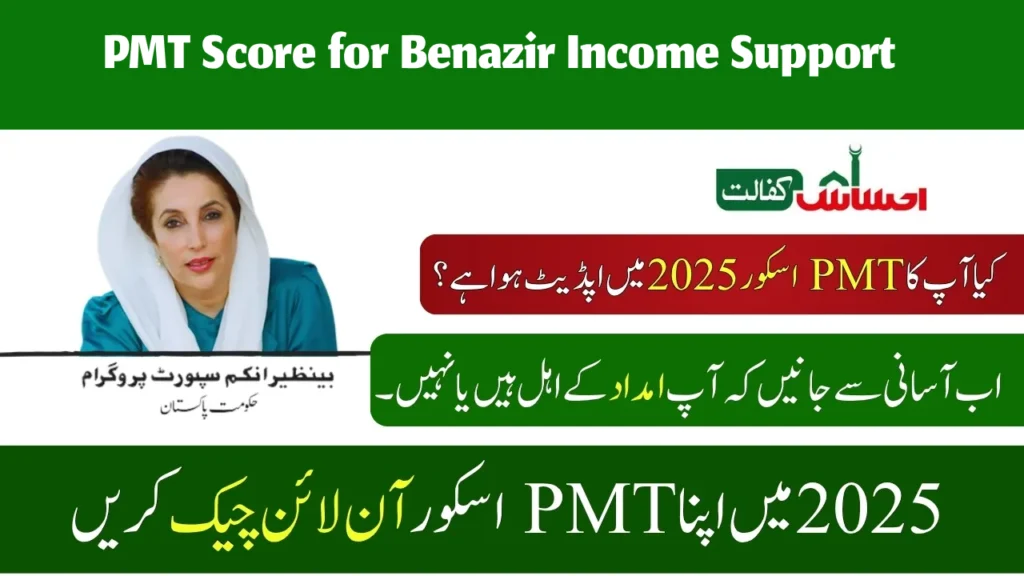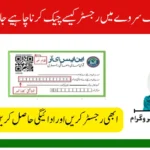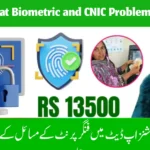
Let’s Talk About the PMT Score
Hey there! So, you’ve heard about the Benazir Income Support Programme (BISP) in Pakistan and something called a PMT score, right? Maybe you’re wondering, “What is the PMT score for Benazir Income Support, and why does it matter?” Well, don’t worry—I’m here to break it down for you like we’re chatting over a cup of chai. Imagine the PMT score as a kind of report card for your household’s financial situation. It helps the government figure out who really needs help from BISP, a program that gives cash to low-income families to make life a little easier. In this article, I’ll explain what the PMT score is, how it’s calculated, who qualifies, and tons more—all in a way that’s super easy to understand. Let’s dive in!
What Exactly is the PMT Score?
Okay, let’s start with the basics. PMT stands for Proxy Means Test. Fancy name, I know, but it’s just a way to measure how much financial help a family might need. Think of it like a score from 1 to 100 that looks at your household’s situation—things like how many people live with you, what kind of house you have, and how much money you earn. The lower your score, the more likely you are to qualify for BISP’s cash assistance. It’s like the government saying, “Hey, we see you need a hand, and we’ve got you!”
The PMT score is a big deal because it decides if you get quarterly payments (like Rs. 13,500 in 2025) or other benefits like school stipends for your kids. It’s not random—it’s based on real info about your life, collected through a survey called the National Socio-Economic Registry (NSER). Cool, right? Let’s keep going.
Why Does the PMT Score Matter for BISP?
Picture this: BISP is like a superhero for low-income families in Pakistan, swooping in with cash to help pay for food, school, or medical bills. But superheroes can’t help everyone at once, so they need a way to find the families who need them most. That’s where the PMT score comes in! It’s like a map that shows BISP who’s struggling the most.
Here’s why the PMT score is so important:
- Fairness: It makes sure the money goes to families who really need it, not just anyone who applies.
- Targeting Poverty: Lower scores mean more financial struggle, so BISP can focus on the poorest households.
- Extra Benefits: A good PMT score can also qualify you for other programs, like education stipends or special aid packages.
- Transparency: The score is calculated by a computer system, so it’s less likely to be unfair or biased.
In 2025, if your PMT score is 32 or lower, you’re likely eligible for BISP’s main cash program, called Benazir Kafalat. If it’s higher, don’t worry—we’ll talk about what you can do later!
How is the PMT Score Calculated?
Alright, let’s get to the fun part—how does this magical number get created? The PMT score comes from a survey where someone from BISP or NADRA (the National Database and Registration Authority) asks you a bunch of questions about your life. It’s like a friendly quiz about your household, but instead of winning a prize, you might get financial help.
Here’s what they look at to calculate your score:
- Family Size: How many people live in your house? More kids or elderly folks can lower your score since they’re often dependents.
- Income: How much money comes in from jobs, businesses, or other sources? Less income means a lower score.
- Housing: Do you own or rent your home? Is it made of mud, bricks, or something fancy? Simpler homes lower your score.
- Assets: Do you own things like a car, livestock, or land? Fewer assets mean a lower score.
- Utilities: Do you have electricity, gas, or clean water? Limited access can lower your score.
- Education: What’s the highest education level in your family? Lower education often means a lower score.
- Health: Are there serious health issues that stop family members from earning? This can lower your score too.
- Location: Living in a rural area might lower your score compared to urban areas.
Each answer gets a point value, and the computer adds them up to give you a score between 1 and 100. If your score is low (like 1–32), you’re considered more in need, and BISP might approve you for aid. It’s like a video game—lower scores unlock the “cash assistance” level!
Who Qualifies for BISP in 2025?
Now that we know what the PMT score is, let’s talk about who can actually get help from BISP. The program is designed to support the most vulnerable people, especially women, because they’re often the ones managing family finances. Here’s the lowdown on who qualifies:
- Women Only: BISP usually gives aid to female heads of households—think widows, divorced women, or married women managing the home.
- PMT Score: Your score needs to be 32 or lower for most BISP programs. But, if you’re a widow, disabled, or transgender, you might qualify with a score up to 37.
- Low Income: Your household income should be low—typically under Rs. 50,000 per month in 2025.
- No Government Jobs: If you or your spouse work for the government or get a pension, you’re usually not eligible.
- Pakistani Resident: You need to live in Pakistan and be a citizen.
- Registered with NSER: You must complete the NSER survey to get a PMT score.
If you check these boxes, you’re in a great spot to apply for BISP’s cash payments or other benefits like the Benazir Taleemi Wazaif (school stipends for kids).
Latest Updates for BISP and PMT in 2025
Things change fast, and BISP is always tweaking its rules to help more people. Here’s what’s new for 2025:
- Higher PMT Threshold: The PMT score limit went up to 34 for some programs, so more families might qualify.
- Increased Payments: The quarterly cash amount is now Rs. 13,500 for eligible families, and it might go up if inflation rises.
- Digital Access: You can now check your PMT score and payment status online or via SMS (more on that later!).
- Dynamic Registry: BISP is making it easier to update your info if your situation changes, like if you lose income or sell assets.
- Special Programs: New initiatives, like the Benazir Hunarmand Programme for skill development, are using PMT scores to find eligible people.
These updates mean more families can get help, and the process is getting smoother. So, if you didn’t qualify before, 2025 might be your year!
How to Check Your PMT Score in 2025
Okay, you’re probably thinking, “This sounds great, but how do I find out my PMT score?” Don’t worry—it’s super easy! Here are the main ways to check your score in 2025:
- Online Portal:
- Go to the official BISP website or the 8171 portal.
- Enter your 13-digit CNIC (your ID card number) without dashes.
- Complete the CAPTCHA (that annoying “prove you’re not a robot” thing).
- Click “Check PMT Score” and boom—your score pops up!
- SMS:
- Grab your phone and text your 13-digit CNIC number to 8171.
- You’ll get a reply with your PMT score and eligibility status. Easy peasy!
- BISP Office or NADRA:
- Visit your nearest BISP Tehsil Office or NADRA center.
- Bring your CNIC and any family details (like a B-Form for kids).
- Ask the staff to check your score or update your survey.
- Mobile App:
- Download the BISP or PMT Score Check app from the Play Store or App Store.
- Enter your CNIC and follow the steps to see your score.
Pro tip: Always double-check your CNIC number to avoid errors. If the website’s slow, try again later or use the SMS option.
Common Mistakes to Avoid When Checking Your PMT Score
Nobody’s perfect, but some mistakes can mess up your PMT score or eligibility. Here’s what to watch out for:
- Wrong CNIC Number: Typing the wrong digits or adding dashes can give you an error. Double-check!
- Outdated Info: If your income, family size, or assets have changed, update your NSER survey pronto.
- Ignoring Blocks: If your account is “blocked” (like if your spouse is a taxpayer), visit a BISP office to fix it.
- Not Verifying: Some people forget to verify their score or eligibility after a survey. Always confirm!
- Falling for Scams: Only use official BISP channels (like the 8171 portal or SMS). Don’t trust random websites or people asking for money.
Avoid these traps, and you’ll be on the fast track to getting your score and aid.
What to Do If Your PMT Score Is Too High
Uh-oh, what if your PMT score is above 32 (or 37 for special cases) and you’re not eligible? Don’t panic—there are ways to fix this! A high score might happen if the survey has old or wrong info about your household. Here’s how to lower your score:
- Update Your Info: Visit a BISP office or NADRA center with your CNIC, proof of income, and family details. If your income dropped or you sold assets, report it.
- Request a Re-Survey: Ask for a new NSER survey to reflect your current situation. This can take a few weeks, so be patient.
- Add Dependents: Make sure all kids, elderly, or disabled family members are listed—they can lower your score.
- Correct Errors: If the survey recorded wrong info (like saying you own a car when you don’t), fix it with proof.
- Check Tax Status: If your spouse is listed as a taxpayer, clarify their status with NADRA to unblock your application.
Keep your info accurate, and your score might drop enough to qualify. Don’t give up!
Benefits of a Good PMT Score
Having a low PMT score is like having a golden ticket to BISP’s support. Here’s what you can get:
- Cash Payments: Quarterly payments of Rs. 13,500 to help with food, bills, or other essentials.
- Education Stipends: The Benazir Taleemi Wazaif program gives money for kids’ school fees.
- Special Aid: You might qualify for one-time payments, like Rs. 25,000 during Ramadan or other relief packages.
- Skill Programs: New initiatives like the Benazir Hunarmand Programme offer training to help you earn more.
- Other Welfare: A low PMT score can qualify you for programs like the Punjab Rashan Card or housing schemes.
These benefits can make a huge difference, especially if money’s tight. Plus, it feels great knowing the government’s got your back!
Step-by-Step Guide to Apply for BISP with Your PMT Score
Ready to apply for BISP? Here’s a simple guide to get started:
- Complete the NSER Survey:
- Wait for a BISP enumerator to visit your home, or go to a BISP registration desk at a Tehsil Office.
- Answer all questions honestly about your family, income, and home.
- Get Your PMT Score:
- Check your score using the online portal, SMS (8171), or at a BISP office.
- Make sure it’s 32 or lower (or 37 for special cases).
- Verify Eligibility:
- Confirm you meet BISP’s criteria (female head of household, low income, etc.).
- Submit documents like your CNIC and proof of income if asked.
- Register for Payments:
- If eligible, sign up for BISP Kafalat or other programs at a BISP office.
- Choose a payment method (like HBL Konnect or JazzCash).
- Collect Your Cash:
- Visit a designated campsite or ATM to get your quarterly payment.
- Check your payment status regularly via the 8171 portal or SMS.
- Update Regularly:
- If your situation changes (new baby, lost job, etc.), update your NSER data to keep your score accurate.
Follow these steps, and you’ll be set to receive BISP’s help!
Tips to Keep Your PMT Score Accurate
Your PMT score isn’t set in stone—it can change as your life does. Here are some tips to keep it accurate:
- Update Yearly: Check your score at least once a year, especially after big life changes like a new job or moving.
- Be Honest: Always give true info during surveys. Lying can get you disqualified.
- Keep Documents Ready: Have your CNIC, family B-Form, and income proof handy for surveys or updates.
- Use Official Channels: Stick to BISP’s website, 8171 SMS, or offices to avoid scams.
- Ask for Help: If you’re confused, call the BISP helpline (0800-26477) or visit an office.
Keeping your score up to date means you won’t miss out on aid you deserve.
Conclusion: Your PMT Score Is Your Key to BISP
So, there you have it—everything you need to know about the PMT score for Benazir Income Support in 2025! It’s like a magic number that opens the door to financial help for families who need it most. Whether you’re checking your score, updating your info, or applying for BISP, the key is to stay informed and keep your details accurate. Think of it like watering a plant—give it a little attention, and it’ll grow (or in this case, get you cash!).
If you’re eligible, don’t wait—check your PMT score today via the 8171 portal or SMS. And if you’re not eligible yet, don’t lose hope. Update your info, request a re-survey, and you might just qualify. BISP is here to help, and with a little effort, you can be part of it. Keep smiling, stay positive, and let’s make 2025 a year of support and success!
FAQs About the PMT Score for BISP
1. What is a good PMT score for BISP?
A score of 32 or lower qualifies you for most BISP programs, like Benazir Kafalat. Widows, disabled people, or transgender individuals can qualify with a score up to 37.
2. Can I check my PMT score for free?
Yes! Checking your PMT score via the 8171 SMS, BISP website, or app is completely free.
3. How often should I update my PMT score?
Update it whenever your situation changes (like income or family size) or at least once a year. You can request a new NSER survey at a BISP office.
4. What if my PMT score is too high?
Visit a BISP or NADRA office to update your info or request a re-survey. Make sure your income, assets, and dependents are accurately reported.
5. Can men apply for BISP?
BISP mainly supports female heads of households. Men can’t usually apply unless they’re transgender or in special cases.
6. How do I know if I’m getting BISP payments?
Check your payment status via the 8171 portal or SMS. You’ll need your CNIC number, and it’ll show if you’re approved and when payments are coming.

